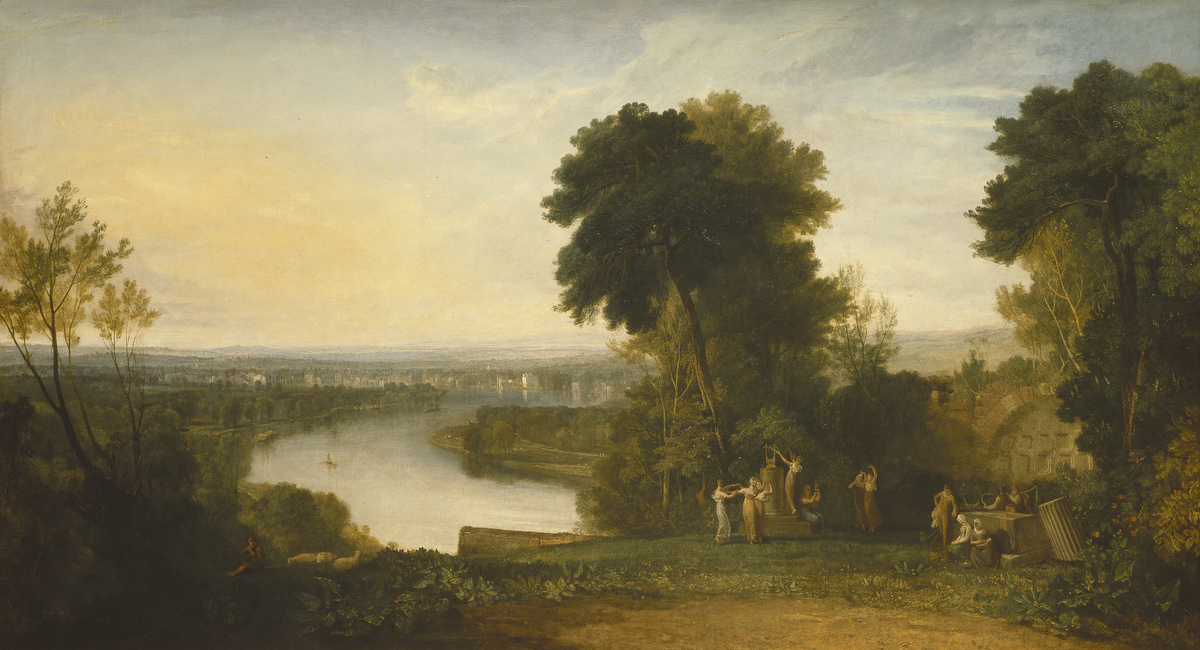Thomson's Aeolian Harp
Joseph Mallord William Turner 1775 - 1851
Summary
A view overlooking the River Thames from Richmond Hill. The River bends in a backwards S shape, small boats scattered along its length. Buildings line the far bank. The trees on the nearer banks are in full dark green foliage, and two groups of trees in the foreground stand prominently punctuating the blue grey sky. A feathery tree to the left completes the composition. There are three loose groupings of figures in the foreground to the right, some near a golden harp mounted on a pedestal, others sitting around a stone plinth amongst classical ruins. The group of three barefoot female dancers holding hands in a ring are the Three Graces, and the four females who are decorating the harp are The Four Seasons. They all wear 18th-century classical dress. On the harp’s pedestal is carved the name ‘THOMSON’. He was a poet who in 1748 published An Ode on Aeolus's Harp, and was also famous for his poem The Four Seasons. The figures behind the plinth to the right of the mounted harp are agricultural labourers. They carry a scythe and a sickle. Various other tools, including a rake, are propped against the plinth. Two women are seated at the front of the plinth, the elder reading a book, a basket by her side, and the younger with a small sheath of corn by her side, talking to a standing youth who wears a ruff. In front of them the grass and plants recede, leaving a patch of ochre earth. A single shepherd boy with three sheep rests on a rocky outcrop in the left foreground, playing a pipe.
Display Label
Grand Tour and Grand Style The Influence of Travel Improvements in European travel during the 1700s had a wide-ranging impact on British culture. A particularly significant influence was the Grand Tour, which became almost obligatory for young gentlemen. Grand Tourists were led across Europe by tutors to study art, history and politics for two or three years. The Grand Tour focused on Italy, particularly Rome, and often incorporated new archaeological sites such as those at Herculaneum and Pompei, near Naples. Ancient antiquities were heavily trafficked across Europe and continental works of art flooded into Britain. A period of especially active collecting took place between the end of the Seven Years War in 1763 and the rise of Napoleon in the 1790s. As more artists and designers also visited the continent their work became increasingly informed by travel. The serious themes of classical antiquity and European art led to a new departure in painting called the Grand Style. This championed classical, historical or literary subjects, and inspired radical changes in portraiture and landscape. Widespread interest in Greek and Roman remains also fostered fresh interpretations of ancient designs by pioneers of decorative art such as Josiah Wedgwood.
Object Name
Thomson's Aeolian Harp
Creators Name
Date Created
1809
Dimensions
Canvas: 166.7cm x 306cm
Travelling frame: 186.5cm x 324.5cm
accession number
1979.7
Place of creation
England
Support
canvas
Medium
oil paint
On Display
[G4] Manchester Art Gallery - Gallery 4
View all
Credit
Accepted in lieu of capital transfer tax by H M Government and allocated to Manchester Art Gallery, 1979
Legal
© Manchester Art Gallery

